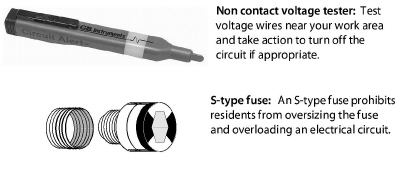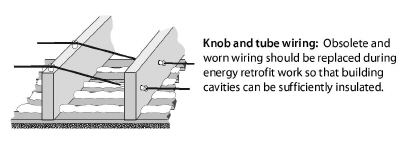
|
SWS Detail: 2.0100.1 Global Worker Safety, 2.0602 Electric Hazards |
Electrical fires and shocks are common and serious safety problems. Electrical safety is a basic housing need, requiring attention during home weatherization and repair.
Observe the following specifications for electrical safety in weatherizing existing homes.
✓ Whenever working around wiring, use a non-contact voltage tester to determine whether circuits are live. Turn circuits off at circuit breakers as appropriate.
✓ Inspect wiring, fuses, and circuit breakers to verify that wiring isn’t overloaded. Install S-type fuses where appropriate to prevent circuit overloading. Maximum ampacity for 14-gauge wire is 15 amps and for 12-gauge wire is 20 amps.
✓ Confirm that all wire splices are enclosed in electrical junction boxes. If you plan to cover a junction box with insulation, attach a flag to mark its location.
✓ Don’t allow metal insulation shields to contact wiring.
✓ Verify that the electrical system is grounded to either a ground rod or to a metallic water pipe with an uninterrupted electrical connection to the ground.
✓ Install S-type fuses where appropriate to prevent occupants from installing oversized fuses if installing insulation.
✓ Perform a voltage-drop test to evaluate the size and condition of hidden wiring on older homes if installing insulation.
✓ Whenever you doubt the integrity of a home’s electrical system, use a generator to power insulation blowers and other large power tools.

1.8.1 Decommissioning Knob-and-Tube Wiring
All knob and tube wiring in areas worked on with WAP funds must have knob and tube decommissioned and replaced with proper wiring. All knob and tube wiring that presents a health and safety hazard in a home must be decommissioned prior to weatherization.

Use a non-contact voltage tester to determine whether the knob-and-tube wiring is live. If you’re unsure about whether the wiring is still live, schedule an inspection by a qualified and experienced electrician.
If the knob-and-tube wiring in an attic is live, ask an electrician and/or an electrical inspector to determine whether the attic wiring can be decommissioned and replaced with non-metallic sheathed electrical cable. Depending on the situation, the electrician may choose one of these two options.
1. Terminate the existing attic knob-and-tube wiring, and connect the new NM circuit directly to the main service box.
2. Install a flagged junction box in the attic to connect the knob-and-tube riser to new NM cable in the attic.
3. Knob and Tube decommissioning must be done according to Minnesota State Electrical Code.
Consider installing a hard-wired CO/smoke detector in a common area near the bedrooms on the new circuit.